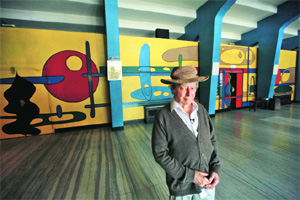“I remember my first night in the city. Habib took me for a cultural performance where his wife Indrani was performing a dance piece,” says Durand. His apartment in Defence Colony was shared by John Bissell, who established popular lifestyle brand Fabindia. “He was still planning Fabindia then,” says Durand.
Luc Durand, architect of many Delhi landmarks of the 1960s, returns to the capital after fifty years
A brightly-coloured wall leads film buffs to India’s first cinema with a 70 mm screen, Sheila Theatre (Habib Rahman architect) in Paharganj. A bold yellow with abstract geometrical figures in red and blue, it was the handiwork of a young Canadian architect Luc Durand. Look closely, and you’ll see his signature on several buildings in the Capital. This week, Durand, now 82, returned to Delhi and revisited some of his early works.
“I had come to Delhi at the invitation of architect Jack Vicajee Bertoli to work on a booking office of Air India in Connaught Place. The project took a few months, but my stay in India lasted three years,” recalls Durand. During those years, he worked on innumerable projects such as the master plan of the Capital for which he collaborated with Ford Foundation, drew plans for the Civic Center near Ram Lila Maidan, and the Pusa Road shopping center as well as a master plan for Calcutta. “All projects were not implemented but it was fun working on them as a youngster,” he recalls.
It’s been 50 years since he was last in India. This time, a documentary by Canadian filmmaker Etienne Desrosiers has brought Durand to the Capital. “The city has grown more than what I had envisioned,” he says, looking around at the high-rises that emerge through the canopy of trees. Ironically, the city’s changing character has also spelled the end of some of Durand’s work — a cinema in Patel Nagar (possibly Vivek Cinema), for instance, has been demolished.
The architect looks fondly at the mural at Sheila Theatre. “It took me three days to complete,” he says, “It was an impromptu design. I took the help of some workers to paint it.” After a while, he adds, “It’s a delight that the mural has been maintained.” Delhi-based architect Habib Rahman had recommended Durand for the Sheila Theatre project.
“I remember my first night in the city. Habib took me for a cultural performance where his wife Indrani was performing a dance piece,” says Durand. His apartment in Defence Colony was shared by John Bissell, who established popular lifestyle brand Fabindia. “He was still planning Fabindia then,” says Durand.
Durand had also designed numerous houses, including the second floor of author Patwant Singh’s home on Amrita Shergill Marg. In 1959 and 1961 he was commissioned to create pavilions for the Agricultural Fair and the Indian Industries Fair of New Delhi.
Back in Montreal, he found that the Indian experience was giving his work a different dimension. “What I learned here enabled me to win a competition to design the Quebec Pavilion for Expo 67,” says Durand. (Expo 67 was the 1967 International and Universal Exposition in Montreal, considered the most successful World Fair of the 20th century).
Several other projects followed, including the 1976 Olympics Village in Montreal and documentary films, Urbanose and Urba, which reflected on the urban fabric and social housing. He is now looking forward to covering a part of the Décarie expressway in Quebec. “I have been working on it for 15 years,” says the architect. He also has an observation about Delhi: “There are too many buildings. The cars also are very long”. Luc Durand Indian Express March 16 2012
Copy Right
All Rights Reserved ©Sukanya Rahman 2011
Categories



